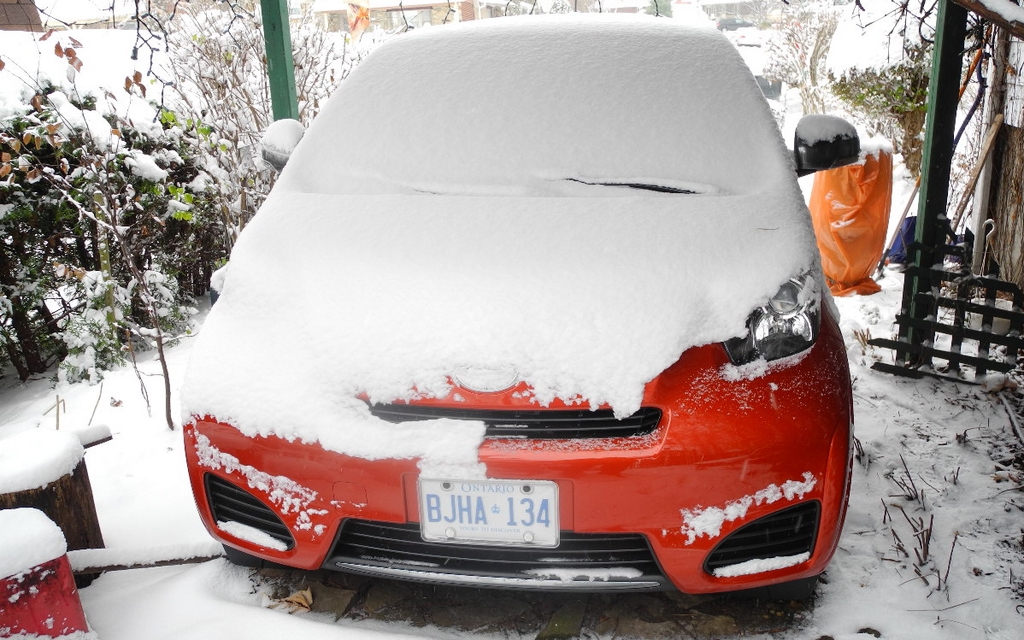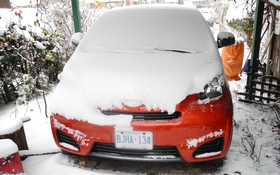2012 Scion iQ: The Scion in Winter

| Strong points |
|
|---|---|
| Weak points |
|
One of the first questions people ask me about small cars is, “How does this vehicle handle in winter?” They already know that the car isn’t terribly roomy, that its performances are respectable at best given the modest engine power, and that its fuel consumption is very economical. But for any good Canadian, winter is a major concern.
I had a Scion iQ to test drive as part of my evaluation for the “North American Car and Truck of the Year” (NACTOY) Awards. As luck would have it, we were unexpectedly broadsided by a fairly significant snowfall, so it was the perfect opportunity to check the vehicle’s winter driving skills. I know, it’s not an exhaustive test, but still, it helped me test certain elements as well as how the car performs on snowy roads.
Dry land first
Before we getting into the details of this little winter escapade, note that this microcar has been sold in Europe for some time under the Toyota banner. For marketing purposes, they preferred to entrust it to the Scion division in North America. For comparison’s sake, we are going to refer periodically to the Fiat 500, another microcar that recently debuted. There’s the Smart, too, but it’s even smaller, so we’re going to have to limit our comparison to the two new kids on the block. Although the little Japanese car appears larger than its Italian competitor at first glance, the Fiat 500 actually has a wheelbase that’s 300 mm longer while its overall length is 502 mm greater.
The Italian comes out on top in terms of power as well. Both have a four-cylinder engine, but the Fiat’s is a 1.4-litre, whereas the iQ has only a 1.3-litre capacity. In fact, with 101 hp, the Fiat has seven more horses than its Japanese rival. The Fiat offers either a six-speed automatic gearbox or a five-speed manual. As for the iQ, it has a CVT. However, since the 500 is 100 kilos heavier, their performances are nearly identical.
In the passenger compartment, the iQ features Scion’s usual styling, such as a prominently positioned radio equipped with controls similar to you might get from an accessory dealer. You’ll get used to it after a few days. The speedometer is located right in the middle of a gauge that also includes the rev counter. Meanwhile, the fuel gauge, odometer and gear position indicator are in a small rectangle on the left of the dashboard. The commands are relatively easy to find and operate. On the vertical console, the three climate control buttons are positioned one above the other. To the right of the stick, there’s the anti-skid deactivation button, USB jack, telephone switch and power door lock button.
Worried about this car’s size in case of impact? You should know that the manufacturer has performed all-out to protect passengers using 11 airbags, including the world’s first hatch airbag. And it isn’t just for show either, since there isn’t much room between the hatch and the backseat passengers. Or rather, I should say passenger, since it’s practically impossible for two people to sit in the back. Essentially, this is a three-seater. A passenger can squeeze into the back on the passenger side because the front seat can be moved forward several centimetres, as there is no glove compartment. Instead, there is a small drawer located under the seat. But considering that the trunk can barely fit a container of windshield washer fluid, the rear bench will almost always remain folded down to have reasonable cargo capacity.
On dry pavement, the iQ’s accelerations are decent for its category and its handling is reliable. Nonetheless, the rather short wheelbase isn’t always compatible with uneven roads. Basically, if the road is bumpy, you’re going to bounce around a lot. Otherwise, its relatively large track width (the distance between the centre of the front wheels and the rear wheels) for its size ensures respectable stability in curves. As for the steering, it’s not overly assisted and is very precise.
On the snow
A little snow on the road doesn’t change anything about the car’s engine, transmission, steering and braking. But performance is another issue entirely.
But before we hit the road, I have to say how much I enjoyed the fact that it was so easy to clear the snow off of this car because of how small it is. Even with a thick layer of snow covering it, a couple of minutes was all it took. Once we were rolling, the defogging system seemed efficient, as any condensation was gone within a couple of minutes.
On the road, I tried my very best to find deeper snow patches so that I could verify ground clearance, the effectiveness of the antiskid system and the ABS brakes. The poorly ploughed parking lot of a municipal arena helped me test all these things. Firstly, unlike many other Toyota products, the iQ’s antiskid isn’t too sensitive. Also note that the car’s 16-inch Dunlop snow tires offered excellent traction.
I tried to fishtail and spin around, but the system proved to be efficient and it intervened in the nick of time: not too soon and, fortunately, not too late either. The ABS brakes don’t have to work too hard considering the lightness of the car. And when I tried to get myself stuck in a snow bank, I found I couldn’t.
Thus, it’s a small city car that should be able to handle itself against the winter. But the roads still have to be ploughed. When Mother Nature leaves a fresh dump of powder, even SUVs have a hard time getting around!











